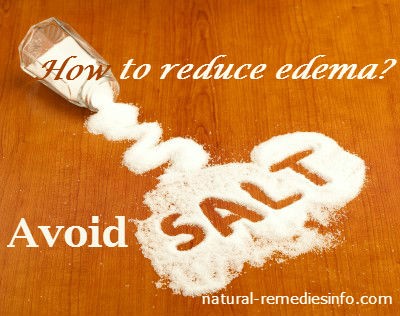The question comes to mind, especially when certain medical conditions have edema as a common side effect. Find out what edema really is and how to naturally reduce edema.
It is more of a symptom rather than a medical condition. Its symptoms are swelling and retention of fluids in the body’s tissues. It is the body’s general response to inflammation and injury. It occurs when small blood vessels release fluid into nearby tissues. The extra fluids accumulates causing the tissues to swell. The common places for edema to occur are feet, ankles and legs.
There are cases that edema is caused by a serious medical condition. Some of these more serious conditions are the following:
- Congestive heart failure. This occurs when one or both of your heart’s lower chambers (ventricles) lose the capability to efficiently pump blood. The blood can be shunted back to your legs, ankles and feet which could cause edema in the lower extremities.
- Liver Cirrhosis. This is a liver disease in which fluid may accumulate in the abdominal cavity and in your lower extremities as a result of alcohol abuse.
- Kidney disease. With a diseased kidney, extra sodium and fluid may circulate in your system which could cause swelling of tissues. Edema can be seen around the eyes and legs.
- Damaged kidneys. A condition called “nephrotic syndrome” may cause edema when damage occurs to the tiny filtering vessels of blood in the kidneys. Since there are declining levels of albumin in the blood, fluid will start accumulating.
- Lymphatic system problems. Since this system helps to clear out fluids that are in excess from the tissues, if this system is damaged, the lymph nodes and lymph vessels that usually drain could possibly have trouble in working correctly.
- Chronic venous insufficiency. In other terms, weak or damaged leg veins that move toward the heart. If the valves aren’t working correctly, blood can be shunted to the lower legs and cause edema.

By James Heilman, MD (Own work) CC-BY-SA-3.0, via Wikimedia Commons - Eating foods with a high amount of sodium (salt) –where sodium goes, water goes. So the more you consume the more water it will attract
- Hypoalbuminemia – having low albumin levels in the blood with act like sponges to keep fluid in the blood vessels.
- Allergic reactions – edema occurs in response to an allergic reaction
- Pregnancy – since there is an increase in blood volume and pressure from the growing womb, mild leg edema is common
- Standing or walking for a long time in warm weather
- Problems with the lymph nodes
- Medications – NSAIDS, calcium channel blockers, corticosteroids
- Liver problems from cirrhosis – this increases fluid retention producing leg edema
- Kidney disease – a condition called “nephrotic syndrome” can cause severe leg edema and sometimes edema in the entire body (“anasarca”)
- Heart disease – A serious medical condition called “congestive heart failure” weakens the heart causing fluid to slowly build up creating leg edema. Sometimes fluid can form in the lungs (pulmonary edema).
- Cerebral edema – this occurs when the brain swells up because of head trauma, high altitude, brain tumors and hydrocephalus (obstruction to fluid drainage).
- Feeling of having tight skin
- Pain with limited movement
- heaviness of the body part affected
- difficulty in breathing due to constriction in the throat
- changes in the levels of oxygen in the body causing life-threatening conditions
Since edema isn’t cured, but could be reduced, your healthcare professional will first find out what the underlying cause of edema is. So the main goal is reducing edema.
In milder cases, you can reduce edema naturally with the following natural remedies:
- Pillow technique. Place a pillow under the edematous area. Making sure it is above your heart so that the swelling will decrease. You could also try raising your feet on the wall while lying flat on your bed.
- Support compression stockings. This could be bought in department stores or healthcare stores. This puts pressure on your legs and keeps water from collecting in the legs and ankles.
- Avoid standing and sitting for long periods of time. When your job consists of standing or sitting for long periods of time, make sure that you move around every once in a while (every 30 minutes to an hour) so that fluid doesn’t accumulate.
- Avoid foods containing sodium and salt. Like mentioned earlier, where sodium goes, water goes. Avoid foods that contain sodium like processed foods, junk food, olives, soy sauces, pickles, hotdogs, burgers, pizzas and salt as a condiment. Also avoid the following foods that are fluid-retaining: white breads, pasta, sugar, backed goods (cookies, crackers, cakes and doughnuts)

- Increase consumption of the following: Whole grain foods, cucumbers, apples, potatoes, grapes, onions, cabbage and oranges.
- Dandelion (Taraxacum mongolicum). To reduce swelling, try using this herb as a natural diuretic. You can find this at herbal stores.
- Deep water therapy. How to reduce swelling fast? This is a great way! Exercising in the swimming pool could do wonders for edema. Water pressure forces excess water out of the body’s tissues and into the bladder.
- Mustard oil. Warm up mustard oil and rub it on the affected area to reduce edema.
- Exercise. By exercising regularly this will help get rid of excess fluid in the body cells and tissues.
- Acupuncture. This traditional Chinese medicine may assist in the removal of fluid. If treatment is done properly, not only will edema be corrected but also the underlying condition if not too severe.
There is a list of ways to help treat edema. Consult with your doctor first about reducing edema before trying out these alternative home remedies to make sure it is safe for you.
